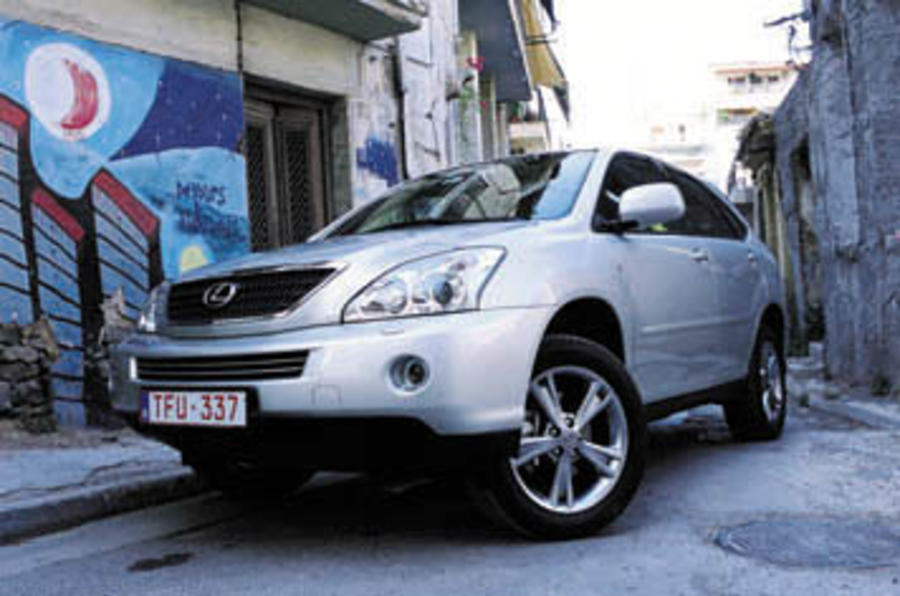Frankly, ‘H’ is an awfully innocuous name for what has to be the world’s most complex production car and, arguably, right now the most interesting, too. ‘Lexus RX400h’ doesn’t exactly punch its weight when you consider the significance wrapped up in that little letter.
As you’ve probably guessed, it stands for ‘hybrid’ or, in Toyota/Lexus speak, ‘Hybrid Synergy Drive’. Nothing especially new here, of course. The Toyota Prius uses the petrol/electric combo powertrain and, remarkably for such a plain-looking family hatchback, has augmented strong sales to the general public with an unprecedented level of celebrity endorsement on the west coast of America. Apparently, it’s a lot easier to spot the stars in Hollywood these days: they all drive Priuses, no doubt in the hope of proving that you can lead an extravagant lifestyle and save the planet at the same time.
Their collective sigh of relief at the launch of the RX400h must be audible on Sunset Boulevard, though. How many, I wonder, will insist on continuing to be seen in the Prius when they could be driving the world’s first high-performance hybrid SUV? This time, what Lexus calls ‘brand-defining technology’ has delivered the real cake-and-eat-it deal.
It comes in the shape of a towering, status-enriched 4x4 that accelerates to 62mph in 7.6sec and has a top speed of 124mph yet returns 35mpg on the combined cycle and posts a jaw-droppingly low (for a full-sized performance SUV) 192g/km carbon dioxide emissions figure. To put that into perspective, a turbo-diesel Land Rover Discovery TDV6 has a 0-60mph time of 12.2sec, does 27.2mpg and produces 275g/km of CO2. Never has the predatory green anti-SUV lobby been quite so wrong-footed by its prey.
The sales potential of the RX400h is massive. Target sales in the UK for the remainder of 2005 are 1625. Orders placed in the US alone currently stand at 18,000 and counting. In 2006, the RX400h is expected to account for half of all RXs sold. And when you take a closer look at what you get for your money, it’s hardly surprising.
Three engines for a start. If you think the way the Prius organises its single petrol and single electric motors to achieve the most efficient team effort is a small miracle, the RX400h’s effort amounts to the full parting of the Red Sea number. It employs a 208bhp 3.3-litre V6 petrol engine and not one but two electric motors – a new and impressively brawny 165bhp unit in the front and the Prius’s 66bhp motor at the back, answering the part time 4x4 brief.
But don’t be tempted to add up all the outputs and conclude that the RX400h can call upon 439bhp. It doesn’t work like that. ‘Synergy’ is the key word, here. In normal driving conditions, the petrol engine’s power output is divided by a power-split device, both to drive the wheels directly and also to power a generator which, in turn, drives the electric motors and simultaneously charges the battery beneath the rear seats. The allocation of power is constantly monitored and adjusted between the petrol engine and the motors to maintain the highest efficiency, not the highest output. The best the RX400 can manage is 269bhp. During deceleration and braking, the petrol engine switches off and the electric motors act as high-output generators.
For the driver, things could hardly be simpler. Climb in, twist the key (no starter motor, not much noise of any sort other than a faint background hum), pull the gear selector into Drive and, well, do just that. If you’re fairly gentle with the throttle, you’ll pull away in something approaching eerie silence as, unless the battery reserve is low or you need to blast Tom Hanks in his Prius away from the lights, the RX400h always starts using electric power alone. And it will always return to it whenever possible. When stationary, it shuts down altogether which, of course, is zero emissions in the truest sense. If the Lexus RX weren’t already the quietest SUV on the planet, it is now.




















Add your comment